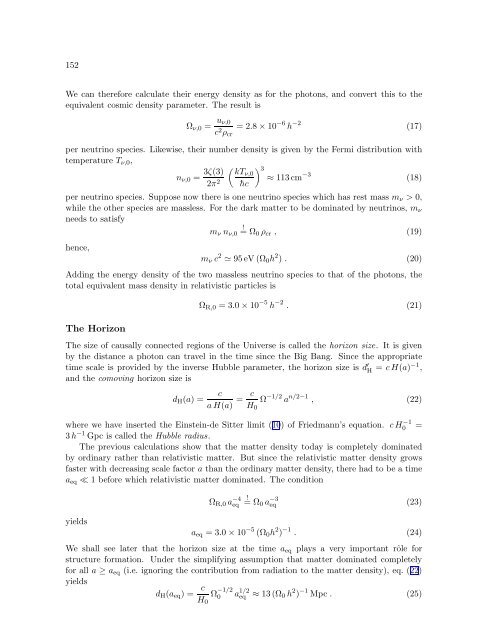Proc. Neutrino Astrophysics - MPP Theory Group
Proc. Neutrino Astrophysics - MPP Theory Group
Proc. Neutrino Astrophysics - MPP Theory Group
Create successful ePaper yourself
Turn your PDF publications into a flip-book with our unique Google optimized e-Paper software.
152<br />
We can therefore calculate their energy density as for the photons, and convert this to the<br />
equivalent cosmic density parameter. The result is<br />
Ων,0 = uν,0<br />
c 2 ρcr<br />
= 2.8 × 10 −6 h −2<br />
per neutrino species. Likewise, their number density is given by the Fermi distribution with<br />
temperature Tν,0,<br />
nν,0 = 3ζ(3)<br />
2π2 � �3 kTν,0<br />
≈ 113cm<br />
¯hc<br />
−3<br />
(18)<br />
per neutrino species. Suppose now there is one neutrino species which has rest mass mν > 0,<br />
while the other species are massless. For the dark matter to be dominated by neutrinos, mν<br />
needs to satisfy<br />
mν nν,0 ! = Ω0 ρcr , (19)<br />
hence,<br />
(17)<br />
mν c 2 ≃ 95eV (Ω0h 2 ) . (20)<br />
Adding the energy density of the two massless neutrino species to that of the photons, the<br />
total equivalent mass density in relativistic particles is<br />
The Horizon<br />
ΩR,0 = 3.0 × 10 −5 h −2 . (21)<br />
The size of causally connected regions of the Universe is called the horizon size. It is given<br />
by the distance a photon can travel in the time since the Big Bang. Since the appropriate<br />
time scale is provided by the inverse Hubble parameter, the horizon size is d ′ H = cH(a)−1 ,<br />
and the comoving horizon size is<br />
dH(a) =<br />
c c<br />
= Ω<br />
aH(a) H0<br />
−1/2 a n/2−1 , (22)<br />
where we have inserted the Einstein-de Sitter limit (10) of Friedmann’s equation. cH −1<br />
0 =<br />
3h −1 Gpc is called the Hubble radius.<br />
The previous calculations show that the matter density today is completely dominated<br />
by ordinary rather than relativistic matter. But since the relativistic matter density grows<br />
faster with decreasing scale factor a than the ordinary matter density, there had to be a time<br />
aeq ≪ 1 before which relativistic matter dominated. The condition<br />
yields<br />
ΩR,0 a −4<br />
eq<br />
!<br />
= Ω0 a −3<br />
eq<br />
(23)<br />
aeq = 3.0 × 10 −5 (Ω0h 2 ) −1 . (24)<br />
We shall see later that the horizon size at the time aeq plays a very important rôle for<br />
structure formation. Under the simplifying assumption that matter dominated completely<br />
for all a ≥ aeq (i.e. ignoring the contribution from radiation to the matter density), eq. (22)<br />
yields<br />
dH(aeq) = c<br />
H0<br />
Ω −1/2<br />
0 a 1/2<br />
eq ≈ 13(Ω0 h 2 ) −1 Mpc . (25)













